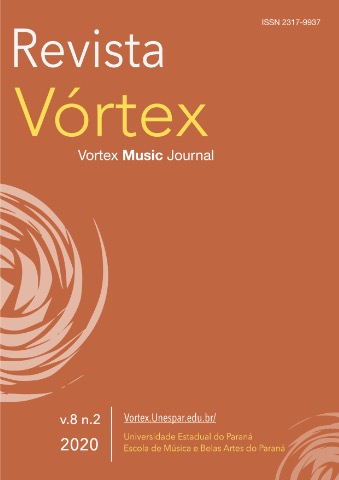Visuals, Structure and Emotion: The Toy Piano in the Dramaturgy of Piano Recitals
DOI:
https://doi.org/10.33871/23179937.2020.8.2.4Keywords:
Toy piano, Piano performance, Piano recital, Artform recital, Dramaturgy.Abstract
This paper examines the contribution of the toy piano to the dramaturgy of piano recitals. As a starting point for the study, the concept of artform recital is introduced, as the understanding that all elements come together with the music programme to build the listening experience. In order to weave all these elements together coherently, it is then proposed the application of ideas from dramaturgy. Three piano recitals are observed as case studies, demonstrating how the addition of toy piano performances can contribute to the dramaturgy of recitals by offering a distinct visual interest, allowing other possibilities of exploration of the space of performance and of the pianist's body movement, suggesting emotional connotations to the listening experience, and by working as a key element in the structure of the programme.Downloads
References
BARBA, Eugenio. The Nature of Dramaturgy: Describing Actions at Work. New Theatre Quarterly 1 (01): 75. doi:10.1017/S0266464X00001421. 1985.
BAKER, Elizabeth Ann, & PANAGIOTOUROS, Fofi. Toyager: a toy piano method. Florida: Elizabeth Ann Baker, 2016.
BURLAND, Karen, & PITTS, Stephanie. (Org.) Coughing and Clapping: Investigating Audience Experience. SEMPRE Studies in the Psychology of Music. Farnham, Surrey; Burlington, VT: Ashgate, 2014.
CLARKE, Eric F. Ways of Listening: An Ecological Approach to the Perception of Musical Meaning. Oxford; New York: Oxford University Press, 2005.
DECOTÉ RODRIGUES, Késia. For a Dramaturgy of the piano recital: an investigation of interdisciplinary strategies for live classical piano performances. 2017. Thesis (PhD). Oxford Brookes University, Oxford.
GE, Rosy Yuxuan. The Art of Recital Programming: A History of the Development of Solo Piano Recitals with a Comparison of Golden Age and Modern-Day Concert Programs at Carnegie Hall. 2017. Dissertation (D.M.A.). University of Kansas.
GOH, Yen-Lin. Toy Orchestra: Serious Art Instrumentas in the Performing of Melodramas. In Malaysian Music Journal. Vol. 4, Num. 1 (34-46), 2015. ISSN 2232-1020.
McCABE, Bret. Peabody's Smooke Debuts Toy Piano Concerto Inspired by Dollhouses, Murder, in Hub (23 April 2014). Available at http://hub.jhu.edu/2014/04/23/smooke-nutshell-peabody/ Accessed on: 19 Feb. 2017
PESTOVA, Xenia. Toy Pianos, Poor Tools: Virtuosity and Imagination in a Limited Context. Manuscript of the author. 2017. Available at https://nottingham-repository.worktribe.com/output/875147/toy-pianos-poor-tools-virtuosity-and-imagination-in-a-limited-context. Accessed on: 01 April 2020. Published in Tempo, 71(281), 27-38. doi:10.1017/S0040298217000456
POOLE, Steven. Tinkle, tinkle little star, in The Guardian (29 Nov 2002). Available at https://www.theguardian.com/music/2002/nov/29/classicalmusicandopera.artsfeatures. Accessed on: 06 May 2020
SAID, Edward Wadie. Remembrances of Things Played: Presence and Memory in the Pianist"™s Art. In Music at the Limits. New York: Columbia University Press, 2008. 11-22
SMALL, Christopher. Musicking: The Meanings of Performing and Listening. Music/culture. Hanover: University Press of New England, 1998.
TURNER, Cathy, & BEHRNDT, Synne K.. Dramaturgy and Performance. Theatre and Performance Practices. Basingstoke; New York: Palgrave Macmillan, 2008.
WEBER, William. Recital. Grove Music Online. Oxford Music Online. Oxford University Press. http://www.oxfordmusiconline.com.oxfordbrookes.idm.oclc.org/subscriber/article/grove /music/23018. Accessed on: 24 Sept 2017
WILLIAMS, Maggie. Child's Play. International Piano (March/April 2007). Available www.isabelettenauer.com/en/reactions/childs-play-international-pian. Accessed: 01 April 2020
Downloads
Published
How to Cite
Issue
Section
License
Copyright (c) 2021 Késia Decoté Rodrigues

This work is licensed under a Creative Commons Attribution 4.0 International License.
Autores mantêm os direitos autorais e concedem à revista o direito de primeira publicação, com o trabalho simultaneamente licenciado sob a Licença Creative Commons Attribution que permite o compartilhamento do trabalho com reconhecimento da autoria e publicação inicial nesta revista.






